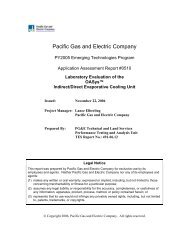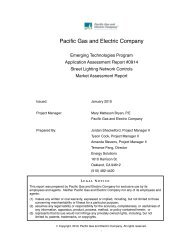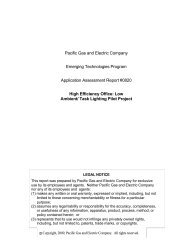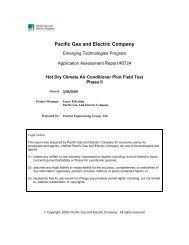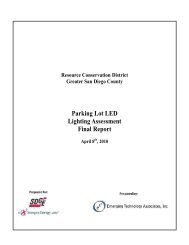Pacific Gas and Electric Company - Emerging Technologies ...
Pacific Gas and Electric Company - Emerging Technologies ...
Pacific Gas and Electric Company - Emerging Technologies ...
You also want an ePaper? Increase the reach of your titles
YUMPU automatically turns print PDFs into web optimized ePapers that Google loves.
Evaluation of the Freus Residential Evaporative Condenser System in PG&E Service Territory<br />
Sensible Cooling EER<br />
16.0<br />
15.0<br />
14.0<br />
13.0<br />
12.0<br />
11.0<br />
10.0<br />
9.0<br />
8.0<br />
7.0<br />
6.0<br />
5.0<br />
Performance Projections<br />
Figure 6: Comparison of Full-Load Sensible Cooling EER<br />
ElkGrove_Freus<br />
ElkGrove_SEER9.5<br />
Redding_Freus<br />
Simulation runs were completed to generate hourly cooling load profiles using the MICROPAS7<br />
computer program for a prototypical 1,882 ft 2 single-story house. Simulations were completed<br />
for both new <strong>and</strong> retrofit cases for the three Central Valley climate zones (11-13) that represent<br />
the climates of Red Bluff, Sacramento, <strong>and</strong> Fresno, respectively. Table 4 summarizes key<br />
envelope characteristics of the new <strong>and</strong> existing house types. In addition to varying the envelope<br />
characteristics, thermostat setpoints <strong>and</strong> daily non-cooling electrical usage assumptions were<br />
varied to assess how these factors would affect savings estimates. Higher cooling setpoints<br />
reduce cooling loads <strong>and</strong> higher non-cooling electrical usage affects the marginal rate for<br />
electricity under PG&E’s five-tiered residential rate E-1. Cooling thermostat setpoints of 76°F<br />
<strong>and</strong> 80°F were modeled for both house types; daily non-cooling energy use estimates of 10<br />
kWh/day were assumed for the 80°F setpoint case, <strong>and</strong> 12 <strong>and</strong> 16.5 kWh for the 76°F setpoint<br />
case 15 . Hourly loads from the simulation runs were used to determine Freus energy<br />
consumption. The Freus efficiency relationship from the Redding site was used to characterize<br />
performance for any hour where the cooling load exceeded 75% of the nominal unit capacity.<br />
For hours where the cooling load was less than 75% of nominal, a 12.5% degradation was<br />
assumed to approximate equipment cycling effects.<br />
15 The varying non-cooling energy use estimates were tied to setpoint to represent higher overall consumption for<br />
homeowners that have lower cooling setpoints.<br />
© Copyright, 2008, <strong>Pacific</strong> <strong>Gas</strong> <strong>and</strong> <strong>Electric</strong> <strong>Company</strong>. All rights reserved.<br />
Page 16<br />
y = -0.0304x + 14.774<br />
R 2 = 0.1405<br />
y = -0.0255x + 13.224<br />
R 2 = 0.2674<br />
y = -0.0363x + 8.9321<br />
R 2 = 0.6743<br />
4.0<br />
60 65 70 75 80 85 90 95 100 105 110<br />
Outdoor Dry Bulb Temperature (F)



